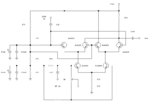neazoi
Advanced Member level 6
In my page http://qrp.gr/regenrxcer/index.htm I have described a regenerative receiver that can under some circumstances receive USB (not LSB).
I need an audio circuit that can do audio spectrum inversion for 200Hz or so to 3KHz or so. This means, the higher audio frequencies must appear lower and the lower, higher.
Is is similar to the analogue audio scramblers I think. This will allow me to distinguish LSB signals as well, by inverting the audio received.
Can this be done some way using simple discrete circuits?
Any info or schematics are appreciated.
Will something like this (replacing the oscillator with a discrete one) be useful?
http://www.discovercircuits.com/Andy/Voice-Scrambler_Descrambler.htm
I need an audio circuit that can do audio spectrum inversion for 200Hz or so to 3KHz or so. This means, the higher audio frequencies must appear lower and the lower, higher.
Is is similar to the analogue audio scramblers I think. This will allow me to distinguish LSB signals as well, by inverting the audio received.
Can this be done some way using simple discrete circuits?
Any info or schematics are appreciated.
Will something like this (replacing the oscillator with a discrete one) be useful?
http://www.discovercircuits.com/Andy/Voice-Scrambler_Descrambler.htm
Last edited:

